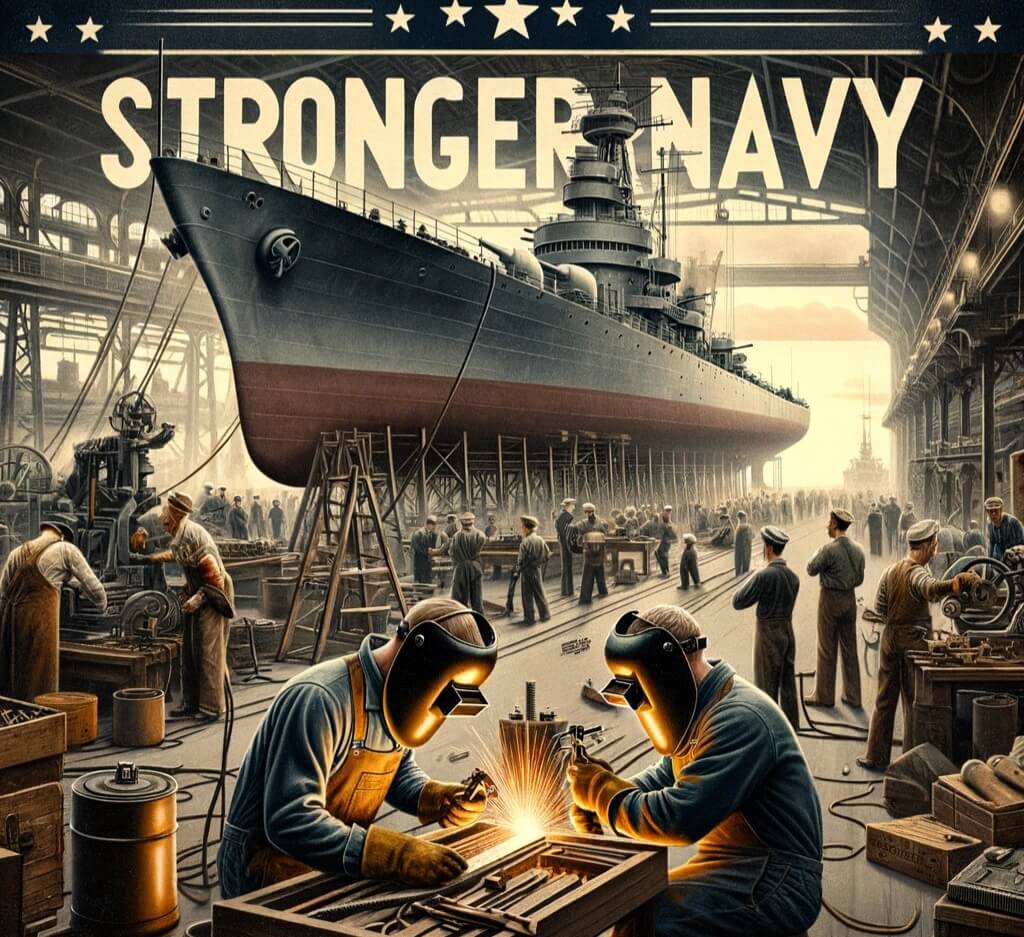
Dear Fellow Americans, Members and Friends of Americans for a Stronger Navy.
Today, we stand at a crucial juncture in our nation’s history, where the strength of our naval fleet is not just a matter of pride, but a critical component of our national security.

As the leader of Americans for a Stronger Navy, I am deeply committed to ensuring that the United States remains a formidable maritime power. This blog series, “U.S. Naval Shipbuilding: Past, Present, and Future – A Nation’s Perspective,” is a clarion call to action. It aims to shed light on the current challenges, draw lessons from our rich history, and chart a course for a future where America leads the seas.
The Problem Defined
The U.S. Navy currently faces unprecedented delays and workforce shortages in shipyards, resulting in postponed vessel deliveries and operational challenges. This not only hampers our fleet readiness but also impacts our ability to respond to global threats effectively.
In a statemet, January 11, 2024, Navy Secretary Carlos Del Toro has ordered a “comprehensive shipbuilding review” to assess both “national and local causes of shipbuilding challenges.”
“I remain concerned with the lingering effects of post-pandemic conditions on our shipbuilders and their suppliers that continue to affect our shipbuilding programs, particularly our Columbia Class Ballistic Missile Submarines and Constellation Class Frigate,” Del Toro.
Historical Context
Reflecting on World War II, the U.S. overcame similar challenges through innovation, rapid expansion, and national mobilization. These lessons from history are vital as we confront today’s challenges.
Why It Matters
Our naval strength is crucial in an era of increasing global tensions.
Dominance at sea is not just about power projection but also about safeguarding international trade routes and ensuring global stability.
Inadequate shipbuilding capacity poses a direct threat to these objectives.
The Navy’s Stance
The U.S. Navy recognizes these challenges, advocating for efficient production practices and skilled labor. There’s an urgent need to modernize shipyards and invest in training programs to meet this demand.
Calling it a “strategic imperative”, Secretary of the Navy Carlos Del Toro urged industry and academia to join efforts to restore the Nation’s competitive shipbuilding and repair landscape.
“We are a nation accustomed to taking on ambitious endeavors, and restoring our maritime strength is no exception.” Del Toro said.
Shipyard Perspectives
Shipyard managers emphasize modernization and investment in workforce training as critical to overcoming current challenges. They advocate for adopting technologies such as automation and advanced materials, and for policies that support the shipbuilding industry.
International Comparisons
Examining successful shipbuilding programs in countries like South Korea and Japan can provide valuable insights into managing efficient and technologically advanced shipyards.
Economic and Environmental Implications
A robust shipbuilding industry is not just a defense asset but also a significant economic driver, creating jobs and fostering technological innovation. Moreover, modern shipbuilding must align with environmental sustainability goals, emphasizing eco-friendly practices.
Public Awareness and Support
It is crucial to increase public awareness and support for naval shipbuilding. This involves understanding the industry’s impact on national security and the economy and recognizing the dedication of those who work in this vital sector.
Role of ‘Americans for a Stronger Navy’
Our organization is committed to highlighting these issues and advocating for a stronger naval fleet. We believe in the power of public support and policy advocacy to drive change.
The Threat and Consequences
Failure to address these challenges could result in a diminished global presence and reduced deterrence capabilities, leaving us vulnerable in an increasingly unpredictable world. The consequences of inaction are stark – diminished naval power in the face of rising global threats.
Public Perspective on U.S. Naval Shipbuilding
In understanding the broader implications of U.S. Naval Shipbuilding, the perspective of the American public plays a crucial role. Recent surveys and public forums indicate a growing awareness of the strategic importance of a strong naval presence for national security.
Many Americans acknowledge the economic impact of the shipbuilding industry, recognizing its role in job creation and technological innovation.
However, there is also a call for greater transparency and efficiency in naval operations and ship construction processes. Concerns about fiscal responsibility and environmental sustainability in shipbuilding practices are increasingly becoming part of the public discourse.
This collective voice underlines the need for a balanced approach that upholds national security interests while addressing public concerns about cost, efficiency, and environmental stewardship.
Conclusion
The need for action is clear. By learning from our past, addressing current challenges, and investing in our future, we can ensure a robust and ready naval fleet. Join us in this series to explore these themes and advocate for a stronger Navy.
Stay tuned for our next post, where we delve deeper into the lessons from World War II and how they can inform our approach today. Let’s move America towards a future of maritime strength and security.
Bill, Founder, Americans for a Stronger Navy

